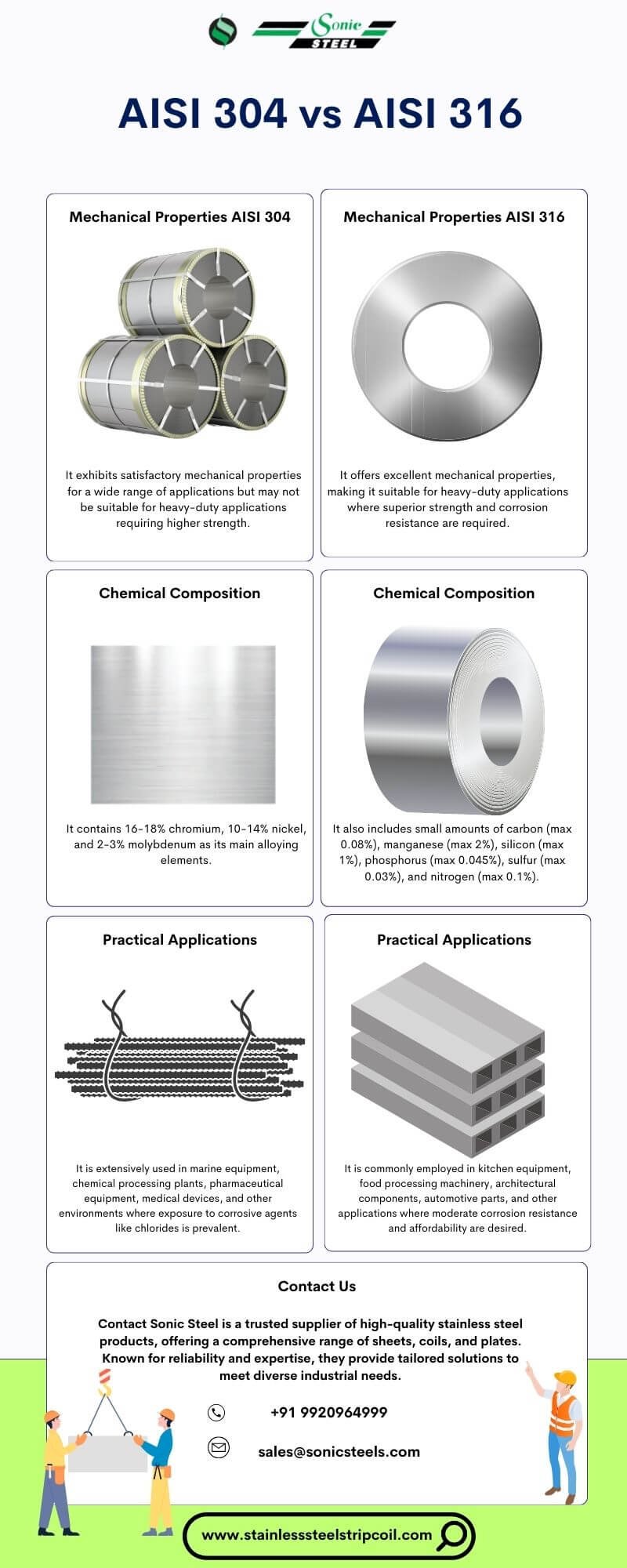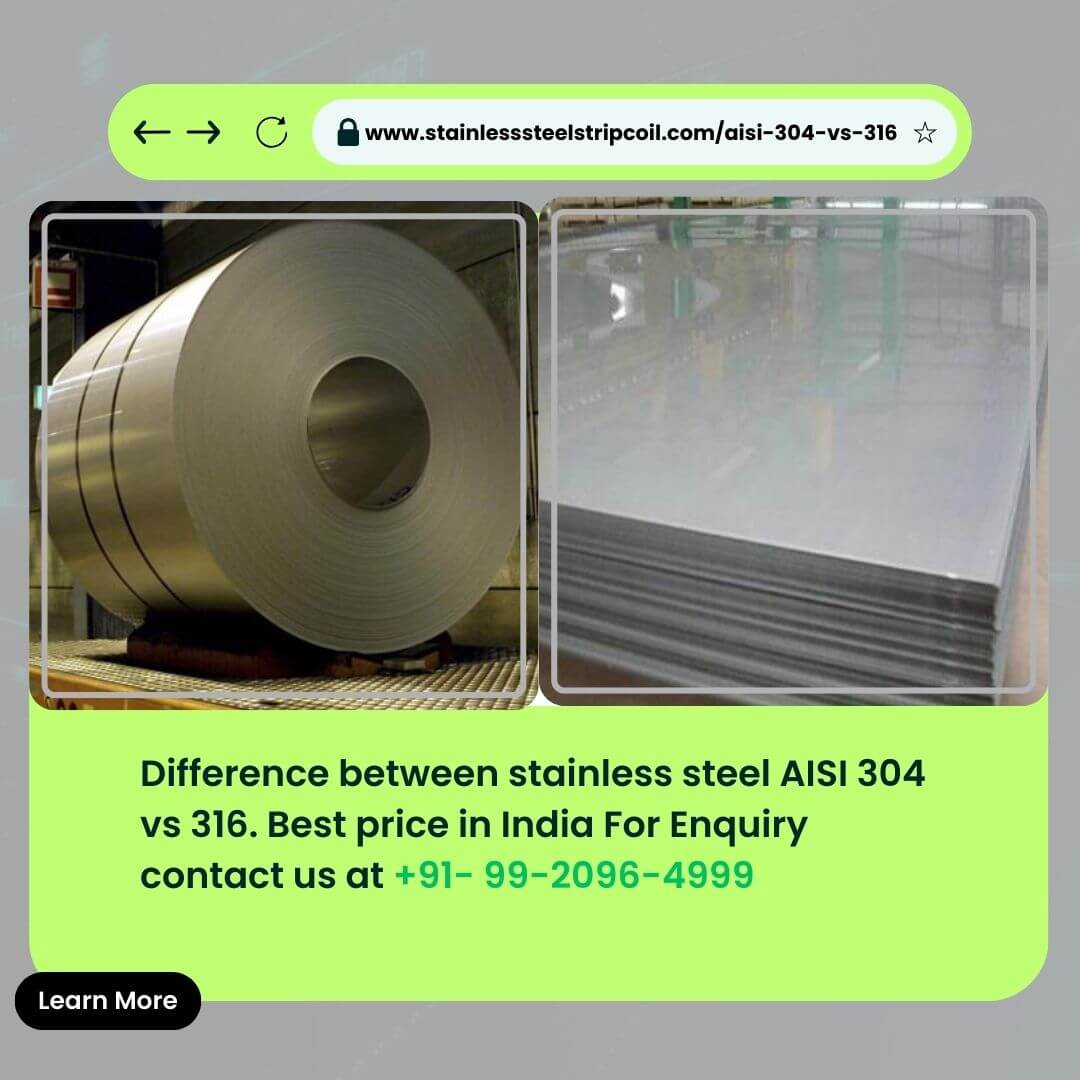There are two most popular stainless steel types called has AISI 304 & 316. Let’s see the differences between AISI 304 & AISI 316 and there uses in different industries, applications, compositions and materials.
AISI 304 Stainless Steel
AISI 304 metal is known for resistant to rust, corrosion resistance in different application has per industries needs. AISI 304 is mainly used in Aerospace, Construction and more.
- Percentage of Component
- 18 to 20% chromium
- 8 to 10.5% nickel
- Carbon less than 0.08%
- Only 2% manganese
- Silicon less than 1%
- About 0.045% phosphorus
- No sulphur ≤0.03%
AISI 316 stainless steel
It’s even tougher and can resist rust even better. Its an upgrade version of 304 stainless steel.
- Percentage of Component
- 16 to 18% chromium
- Nickel 10 to 14 percent
- Molybdenum 2% to 3%
- Carbon less than 0.08%
- Only 2% manganese
- Silicon less than 1%
- About 0.045% phosphorus
- No Sulphur ≤0.03%
Here’s a comparison table highlighting the differences between AISI 304 and AISI 316 stainless steel in various applications
Stainless steels stand out due to their exceptional resistance to rust. Their combination of strength and minimal care requirements make them ideal for various applications. They are prevalent in building materials, construction, medical devices, and food equipment. In certain situations, preventing rust is crucial for a structure’s long-term integrity. Rust can deteriorate metal, weakening its ability to support loads over time. Temperature fluctuations significantly influence corrosion, speeding up the process and creating demanding conditions. Stainless steels excel in such environments. They outperform coated structural steels since coatings tend to be more susceptible to damage under these conditions.

| Application | AISI 304 Stainless Steel | AISI 316 Stainless Steel |
| General Purpose Use | Mainly used for general-purpose applications. | Suitable for general-purpose use with enhanced corrosion resistance. |
| Food Processing | Commonly used in food processing equipment. | Preferred choice for food processing due to superior corrosion resistance. |
| Architectural | Used for building facades, handrails, and decorative elements. | Offers better resistance to atmospheric corrosion, suitable for architectural applications. |
| Household Appliances | Found in kitchen sinks, countertops, and appliances. | Used in household appliances due to corrosion resistance and durability. |
| Marine Applications | Less suitable for marine environments due to moderate corrosion resistance. | Highly resistant to corrosion in marine environments, preferred choice for boat fittings and offshore structures. |
| Chemical Processing | Limited resistance to corrosive chemicals and acids. | Superior resistance to corrosive chemicals, ideal for chemical processing equipment. |
| Medical Equipment | Not typically used in medical applications. | Biocompatible and resistant to corrosion in bodily fluids, commonly used in medical instruments and implants. |
| Pharmaceutical Industry | Limited use due to susceptibility to corrosion from sterilizing agents. | Offers excellent resistance to sterilizing agents, suitable for pharmaceutical manufacturing equipment. |
AISI 316 Chemical Composition
Here’s a comparison table showing the chemical composition of AISI 304 and AISI 316 stainless steel in abbreviated form:
304 and 316 stainless steels differ in their chemical composition. 304 has 18% chromium and 8% nickel, making it good at resisting rust in general. 316, on the other hand, has more things like molybdenum, which helps it fight off rust even better, especially in rough places like the ocean. So, 304 is like a regular recipe that’s fine for most things, while 316 is like adding extra stuff to make it stronger, particularly in tough conditions.
| Element | AISI 304 Composition (%) | AISI 316 Composition (%) |
| Carbon (C) | ≤ 0.08 | ≤ 0.08 |
| Chromium (Cr) | 18.0-20.0 | 16.0-18.0 |
| Nickel (Ni) | 8.0-10.5 | 10.0-14.0 |
| Manganese (Mn) | ≤ 2.0 | ≤ 2.0 |
| Silicon (Si) | ≤ 1.0 | ≤ 1.0 |
| Phosphorus (P) | ≤ 0.045 | ≤ 0.045 |
| Sulphur (S) | ≤ 0.03 | ≤ 0.03 |
| Nitrogen (N) | ≤ 0.10 | ≤ 0.10 |
| Molybdenum (Mo) | – | 2.0-3.0 |
Choosing with Sonic Steel
At Sonic Steel, we’re here to help you pick the right stainless steel for your project. Whether you need something tough like AISI 304 or super strong like AISI 316, we’ve got what you need. Just tell us what you’re looking for, and we’ll make sure you get the best quality stainless steel that suits your needs perfectly.
People Also Search For
aisi 304 stainless steel, aisi 304, material aisi 304, aisi 304 chemical composition, stainless steel aisi 304, aisi 304 vs 316, aisi 316, aisi 316 material, aisi 304 316, aisi 304 316 difference, aisi 304 316l, aisi 304 vs 316 mechanical properties, aisi 304 vs aisi 316, aisi 316 304, aisi 316 vs 304, aisi 316 vs aisi 304, stainless steel aisi 304 vs 316, aisi 304 price, aisi 316 price, aisi 304 cost, aisi 316 cost, aisi 304 price per kg, aisi 316 price per kg, aisi 304 price per ton, aisi 316 price per ton

